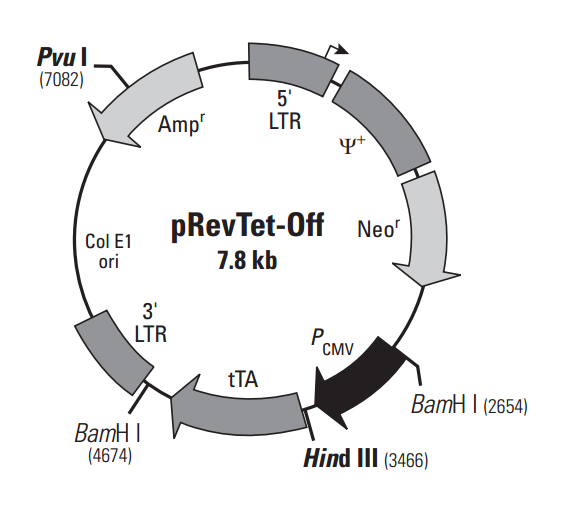pRevTet-Off 载体
| 质粒类型: | 四环素调控系统 |
|---|---|
| 启动子: | CMV |
| 克隆方法: | 多克隆位点,限制性内切酶 |
| 载体大小: | 7847 bp (查看载体序列) |
| 载体抗性: | Ampicillin (氨苄青霉素) |
| 筛选标记: | 新霉素 |
pRevTet-Off™ is a retroviral vector expressing the tetracycline-controlled transactivator (tTA) from the CMV promoter. This vector is derived from pLNCX, a retroviral vector created using elements of Moloney murine leukemia virus (MoMuLV) and Moloney murine sarcoma virus (MoMuSV) as described (1). tTA is a fusion of amino acids 1–207 of the tet repressor (TetR) and the negatively charged C-terminal activation domain (130 amino acids) of the VP16 protein of Herpes Simplex Virus. The 5' viral LTR controls expression of the transcript that contains Y+ (the extended viral packaging signal), and the neomycin resistance gene (Neor) for antibiotic selection in mammalian cells. tTA is derived from vectors described previously (2, 3). pRevTet-Off also includes the E. coli Ampr gene for antibiotic selection in bacteria.
载体应用
pRevTet-Off can be used to establish stable Tet-Off cell lines via retrovirus-mediated gene transfer (4). Retroviral gene transfer allows the highly efficient transduction of virtually all dividing cell types. The RevTet™ Systems are also suitable for establishing transgenic animals. In combination with the pRev-TRE retroviral expression vector, a gene of interest can be inducibly expressed at high levels in response to varying concentrations of tetracycline (Tc) or Tc derivatives such as doxycycline (Dox). tTA binds to the Tet-response element (TRE), thus activating transcription in the absence of Tc or Dox. As Tc or Dox is added to the culture medium, transcription from the inducible promoter is turned off in a highly dose-dependent manner. pRevTet-Off lacks the viral genes gag, pol, and env, which are supplied by the packaging cell line. It can be transfected into a high titer packaging cell line and thereby mediate production of infectious, replication-incompetent retroviral particles (1, 5–6).The transcript produced by the pRevTet-Off construct is recognized by the viral structural proteins expressed in a packaging cell line and packaged into infectious retroviral particles. Because the RNA transcript packaged in these particles does not contain the viral genes, it cannot replicate in the target cells that it infects.
The level of induction in cell populations infected with this vector depends on the efficiency of infection, the site of integration, and the titer of the virus. Viral supernatants with titers >105 cfu/ml should be produced to achieve high-level induction.


